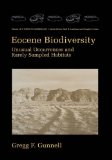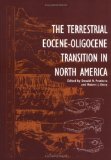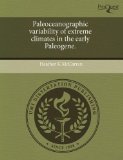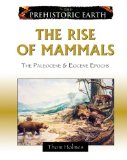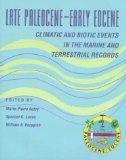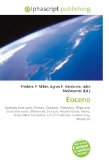Eocene
- A high resolution Lutetian-Bartonian planktonic foraminiferal zonation in the Crimean-Caucasus region of the northeastern Peri-Tethys

- A high resolution study of trace elements and stable isotopes in oyster shells to estimate Central Asian Middle Eocene seasonality

- A model–data comparison for a multi-model ensemble of early Eocene atmosphere–ocean simulations: EoMIP

- Assessing paleotemperature and seasonality during the Early Eocene climatic optimum (EECO) in the Belgian basin by means of fish otolith stable O and C isotopes

- Astronomical modulation of late Palaeocene to early Eocene global warming events

- Astronomical pacing of late Palaeocene to early Eocene global warming events

- Bartonian-Priabonian larger benthic foraminiferal events in the Western Tethys

- Basement Types, Lower Eocene Series, Upper Eocene Olistostromes and the Initiation of the Southern Thrace Basin, NW Turkey

- Biomagnetostratigraphic analysis of the Gorrondatxe section (Basque Country, Western Pyrenees): Its significance for the definition of the Ypresian/Lutetian boundary stratotype

- Biostratigraphy of larger foraminifera in the Eocene (upper Ypresianlower Bartonian) sequences of the Southern Slope of the Western Caucasus (Russia, NE Black Sea). Correlation with regional and standard planktonic foraminiferal zones

- Biotic impact of Eocene thermal maximum 2 in a shelf setting (Dababiya, Egypt)

- Campo section (Pyrenees, Spain) revisited: Implications for changing benthic carbonate assemblages across the Paleocene-Eocene boundary

- Chronostratigraphic terminology at the Paleocene/Eocene boundary

- Coherent pattern and timing of the carbon isotope excursion and warming during Eocene Thermal Maximum 2 as recorded in planktic and benthic foraminifera

- Constraints on the numerical age of the Paleocene/Eocene boundary

- Decline of coral reefs during late Paleocene to early Eocene global warming

- Depth-dependency of the Paleocene-Eocene Carbon Isotope Excursion: paired benthic and terrestrial biomarker records (ODP Leg 208, Walvis Ridge)

- Dispersals of placental carnivorous mammals (Carnivoramorpha, Oxyaenodonta & Hyaenodonta) near the Paleocene-Eocene boundary: a climatic and almost worldwide story

- Early Eocene equable climate problem revisited

- Echinoids of the Middle Eocene Warley Hill Formation, Santee Limestone, and Castle Hayne Limestone of North and South Carolina

- Eocen (in romanian)
- Eocene
- Eocene

- Eocene Calibration of Geomagnetic Polarity Time Scale Reevaluated: Evidence from the Green River Formation of Wyoming

- Eocene Epoch
- Eocene Epoch
- Eocene Epoch
- Eocene Fossils
- Eocene Hyperthermal Event Offers Insight Into Greenhouse Warming

- Eocene Mammals
- Eocene - the Age of Mammals
- Eocene to Early Oligocene turbidite sedimentation in the SE Aegean (Karpathos Island, SE Greece): stratigraphy, facies analysis, nannofossil study, and possible hydrocarbon potential

- Evidence for abundant isolated magnetic nanoparticles at the Paleocene–Eocene boundary

- Evidence of Late Paleocene - Early Eocene hyperthermal events in biosiliceous sediments of Western Siberia and adjacent areas

- Excess Barite Accumulation during the Paleocene/Eocene Thermal Maximum: Massive Input of Dissolved Barium from Seafloor Gas Hydrate Reservoirs

- Export Productivity and Carbonate Accumulation in the Pacific Basin at the Transition from Greenhouse to Icehouse Climate (Late Eocene to Early Oligocene)

- Extinction and food at the sea floor: a high-resolution benthic foraminiferal record across the Initial Eocene Thermal Maximum, Southern Ocean Site 690

- Facies analysis, reservoir characterization, and LIDAR modeling of an Eocene lacustrine delta, Green River Formation, Southwest Uinta basin, Utah

- Floristic composition and comparison of middle Eocene to late Eocene and Oligocene floras in North America

- Floristic composition and variation in late Paleocene to early Eocene floras in North America

- Foraminiferal, palynomorph, and diatom biostratigraphy and paleoenvironments of the Torsk Formation: A reference section for the Paleocene-Eocene transition in the western Barents Sea

- Foraminiferal Biostratigraphy and Palaeoenvironmental Reconstruction of the Paleocene–Eocene Transition at the Kharrouba Section, Tunisia (Southern Tethys Margin)

- Global Standard Stratotype-section and Point (GSSP) for the base of the Eocene Series in the Dababiya section (Egypt)

- Global Stratotype Section and Point (GSSP) for the base of the Lutetian Stage at the Gorrondatxe section, Spain

- High resolution cyclostratigraphy of the early Eocene – new insights into the origin of the Cenozoic cooling trend

- High-resolution deep-sea carbon and oxygen isotope records of Eocene Thermal Maximum 2 and H2 and implications for the origin of early Paleogene hyperthermal events

- High resolution planktic foraminiferal biostratigraphy and correlation across the Paleocene/Eocene boundary in the Tethys

- High-Resolution Stable Isotope Records across the Paleocene/Eocene Boundary, ODP Sites 1220 and 1221

- Impact of Paleocene-Eocene global warming on microbenthic community structure: using rank-abundance curves to quantify ecological response

- Integrated Biostratigraphy of Eocene Deposits in the Gubs Section (Northern Caucasus) with special Attention to the Ypresian/Lutetian Boundary and to the Peritethyan-Tethyan Correlation

- Integrated magnetostratigraphy of the Early/Middle Eocene transition at Agost (Spain): implications for defining the Ypresian/Lutetian boundary stratotype

- Integrated Stratigraphy across the Paleocene/Eocene boundary at Caravaca, Southern Spain

- Integrated Stratigraphy and Chronostratigraphy across the Ypresian-Lutetian transition at Fortuna section (Betic Cordillera, Spain)

- Large-scale glaciation and deglaciation of Antarctica during the late Eocene

- Late Middle Eocene primate from Myanmar and the initial anthropoid colonization of Africa

- Late Paleocene–early Eocene Tethyan carbonate platform evolution — A response to long- and short-term paleoclimatic change

- Lower-middle Eocene benthic foraminifera from the Fortuna Section (Betic Cordillera, southeastern Spain)

- Major shifts in calcareous phytoplankton assemblages through the Eocene-Oligocene transition of Tanzania and their implications for low-latitude primary production

- Mammalian faunal turnover across the Paleocene-Eocene boundary in NW Europe: the roles of displacement, community evolution and environment

- Middle Eocene calcareous algae from the Prang Formation of the Therria area, East Khasi Hills, Meghalaya, N. E. India

- Middle Eocene Paleo Map
- Middle to Late Eocene paleoenvironmental changes in a marine transgressive sequence from the northern Tethyan margin (Adelholzen, Germany)

- New Data on the Dasycladales from the Lower Eocene of Seyitgazi Region, Eskişehir, Central Turkey

- Palaeoceanographic and biotic response during early Eocene extreme global warming events

- Paleocene and Eocene floristic and climatic change in Russia and Northern Kazakhstan

- Palaeocene-Eocene Thermal Maximum super greenhouse: biotic and geochemical signatures, age models and mechanisms of global change

- Palaeoenvironmental turnover across the Ypresian-Lutetian transition at the Agost section, southeastern Spain: in search of a marker event to define the Stratotype for the base of the Lutetian Stage

- Palynology, biomarker assemblages and clay mineralogy of the Early Eocene Climate Optimum (EECO) in the transgressive Krappfeld succession (Eastern Alps, Austria)

- Patterns and magnitude of deep sea carbonate dissolution during Eocene Thermal Maximum 2 and H2, Walvis Ridge, southeastern Atlantic Ocean

- Planktic foraminiferal turnover and ∂13C isotopes across the Paleocene-Eocene transition at Caravaca and Zumaya, Spain

- Presence of several clades of continental turtles in the Lutetian (Middle Eocene) of the Sobrarbe Formation (Ainsa Basin, South-Central Pyrenees, Northeast Spain)

- Productivity feedback did not terminate the Paleocene-Eocene Thermal Maximum (PETM)

- Productivity response of calcareous nannoplankton to Eocene Thermal Maximum 2 (ETM2)

- Progression of environmental changes during the onset of the Paleocene-Eocene thermal maximum (New Jersey Coastal Plain)

- Rapid Acidification of the Ocean During the Paleocene-Eocene Thermal Maximum

- Reassessment of the Early-Middle Eocene biomagnetochronology based on evidence from the Gorrondatxe section (Basque Country, western Pyrenees)

- Recalibration of the Tethyan shallow-benthic zonation across the Paleocene-Eocene boundary: the Egyptian record

- Redefinition of the Ilerdian Stage (early Eocene)

- Response of marine ecosystems to deep-time global warming: a synthesis of biotic patterns across the Paleocene-Eocene thermal maximum (PETM)

- Role of new Iberian finds in understanding European Eocene mammalian paleobiogeography

- Sedimentary Properties of the Middle−Upper Eocene Formations in Çardak, Burdur and İncesu, SW Turkey

- Southern ocean warming, sea level and hydrological change during the Paleocene-Eocene thermal maximum

- Stable isotopic response to late Eocene extraterrestrial impacts

- Stratigraphic and Palaeoenvironmental Significance of Bartonian–Priabonian (Middle–Late Eocene) Microfossils from the Başçeşme Formation, Denizli Province, Western Anatolia

- Stratigraphy and age of the Eocene Igtertivâ Formation basalts, alkaline pebbles and sediments of the Kap Dalton Group in the graben at Kap Dalton, East Greenland

- Stratigraphy and biostratigraphy (charophytes) of the marine-terrestrial transition in the Upper Eocene of the NE Ebro Basin (Catalonia, Spain)

- Stratigraphy and Larger Foraminifera of the Eocene Shallow-marine and Olistostromal Units of the Southern Part of the Thrace Basin, NW Turkey

- Stratigraphy and Larger Foraminifera of the Middle Eocene to Lower Oligocene Shallow-Marine Units in the Northern and Eastern Parts of the Thrace Basin, NW Turkey

- Timing, cause and impact of the late Eocene stepwise sea retreat from the Tarim Basin (west China)

- Tracing the Eocene–Oligocene transition: a case study from North Bohemia

- Warm Paleocene/Eocene climate as simulated in ECHAM5/MPI-OM

- Warming the fuel for the fire: Evidence for the thermal dissociation of methane hydrate during the Paleocene-Eocene thermal maximum

Books about Eocene
